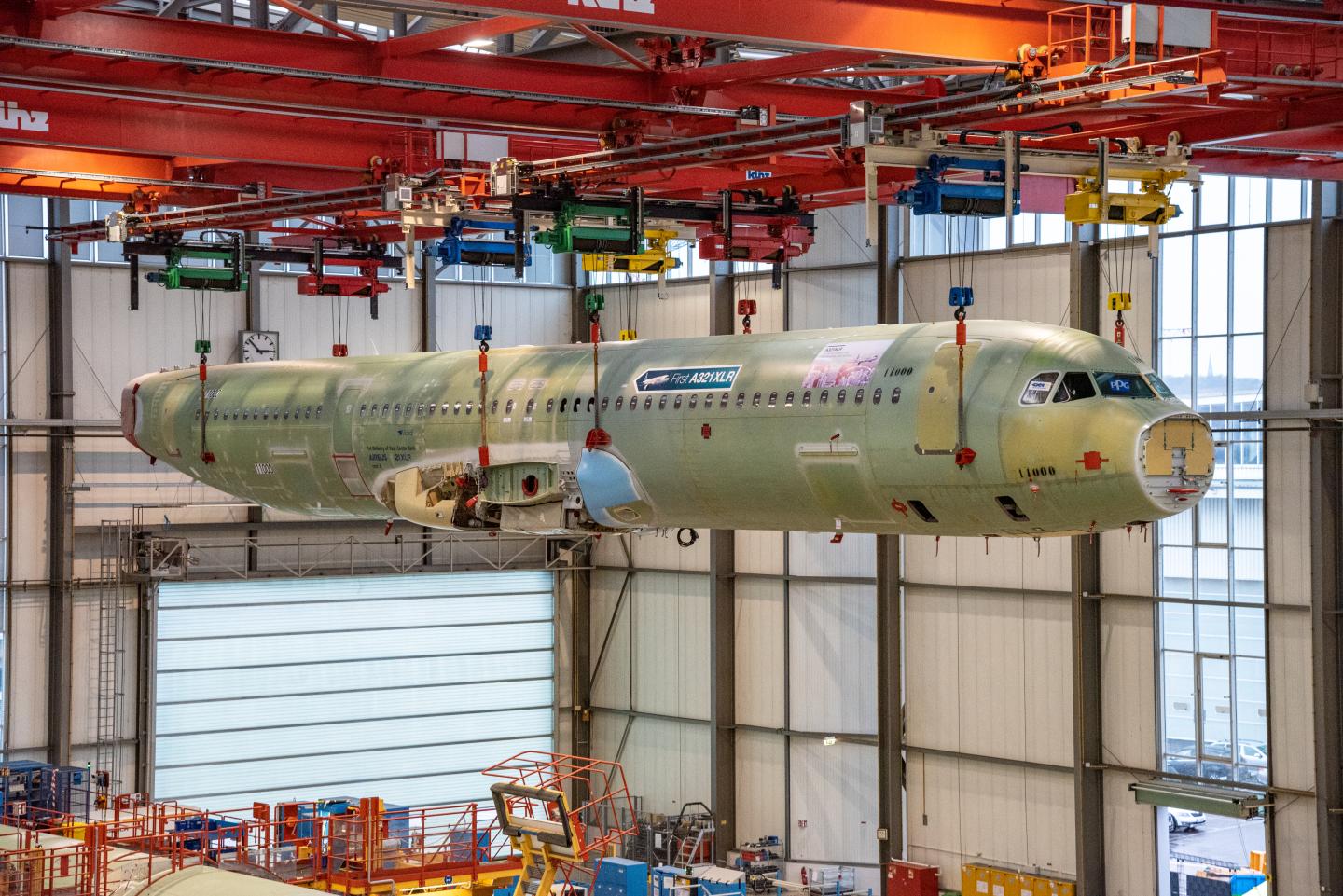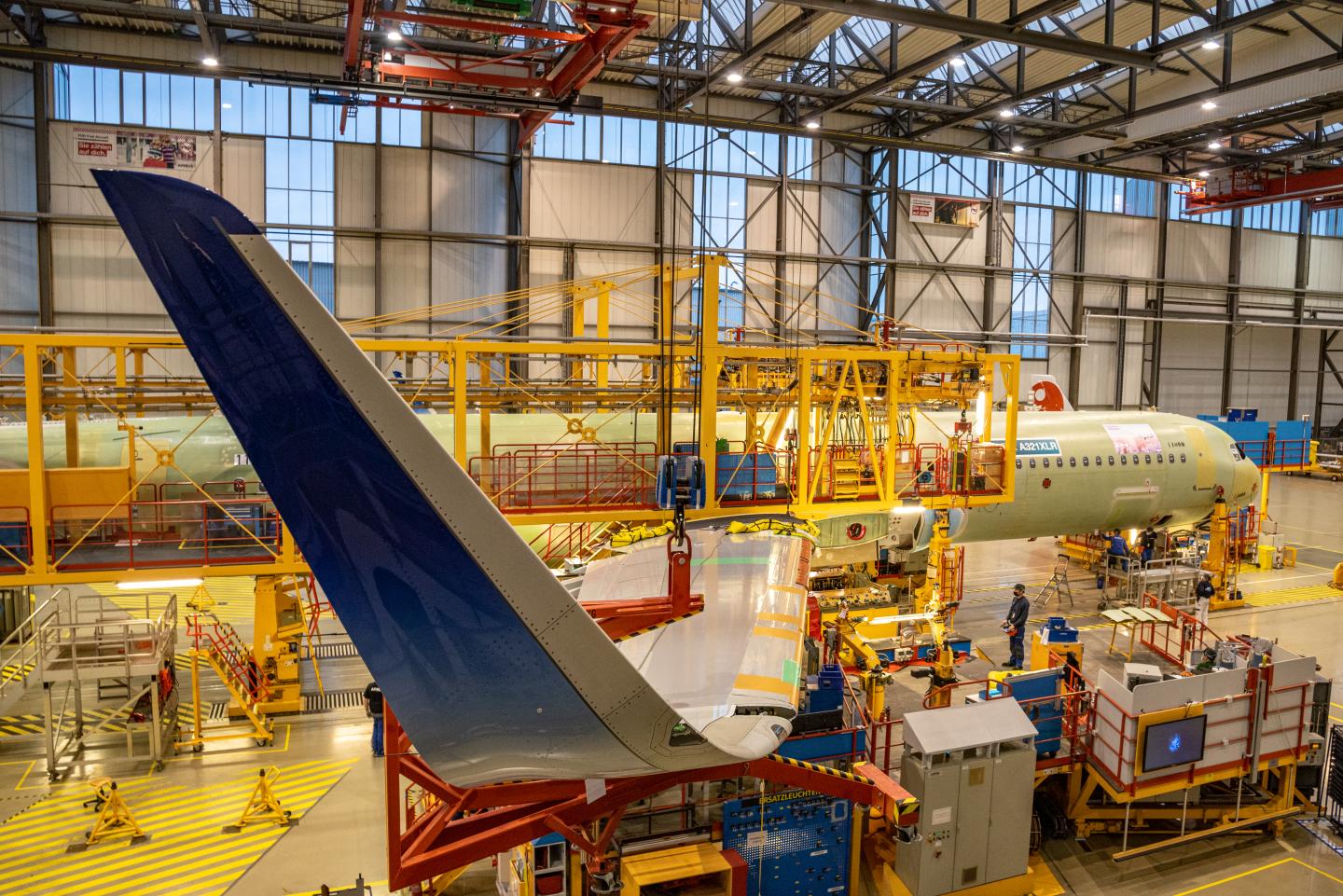One of the most hotly selling aircraft at the Paris Airshow 2019 was the Airbus A321 XLR, which rounded up orders from across the globe, including India’s IndiGo. IndiGo has 386 A321neo aircraft on order (including the XLRs) as of November 30, 2021. The aircraft, however, is just about getting started with the test programme at the moment.

First A321XLR completes structural join up
The very first A321XLR flight test aircraft, MSN11000, took a significant step forward this week in becoming a reality. This is the first of three planned development aircraft which will perform the flight testing and Type Certification programme, starting in 2022, to pave the way for series production and entry into service in 2023.
The structural completion of MSN11000 in the Final Assembly Line (FAL) in Hamburg follows the recent assembly and equipping of the Major Component Assemblies (MCAs) and their subsequent delivery and introduction on schedule into the FAL in November. These MCAs notably included (but were not limited to): the nose and forward fuselage, delivered from Saint Nazaire; the centre and aft fuselage assembled in Hamburg; the wings from Broughton; the landing gears supplied by Safran, and the vertical and horizontal tailplanes from Stade and Getafe respectively.
While other Airbus FAL locations will eventually be producing A321XLRs to fulfil the type’s impressively large customer order-book, Hamburg has been chosen to ‘pilot’ this new variant into series production. This is starting with the three development flight test aircraft – now in various stages of completion there.
Of the four A320 Family assembly lines in Hamburg, the one processing the first A321XLR is referred to as “FAL Line 2”, which is inside the “Hangar-9” building. The subsequent two A321XLR development aircraft – MSN11058 and MSN11080 – will follow in due course from the same assembly line.
Coming together in the FAL Hangar-9
Once all the MCAs for the initial -XLR aircraft had reached the FAL, they subsequently came together at a series of “Stations” to create a whole recognisable aircraft. The journey through these stations took approximately four weeks and comprised the following:
At Station 42/43, the open and separate aft and forward fuselage sections offered the accessibility to receive their fully equipped monuments (galleys, lavatories).

Subsequent “join-up” of these fuselage sections and final installation of the monuments took place at Station 41. Here over 3,000 rivets joined the forward and rear fuselage sections. Importantly, these fuselage sections contained the A321XLR’s vital new enabler: its special Rear-Centre-Tank (RCT) produced by Premium Aerotec. The RCT holds the extra 12,900 litres of fuel needed for its very long-range 4,700nm capability. The XLR’s lower fuselage also contains a larger waste-water tank for the extra-long flights. In addition, the interior furnishing (floor panels, cargo loading system and cockpit linings) and cabin electrical systems were also fitted at Station 41.

With the above stage completed, the teams in the FAL carefully raised the whole fuselage section by overhead crane and then lowered it into a jig at the next station: Station 40. This was the most visually impressive stage, where they physically positioned the awaiting wing and landing gear assemblies right up to their new fuselage with sub-millimetric precision.

Around 2,400 rivets were then used to ensure a robust connection of both wings to the fuselage. Here the aircraft also received its Toulouse-made engine pylons. Another milestone at this station was the functional electrical “power-on”. From then on, the aircraft no longer needed a crane since it could be pulled on its wheels to the next station.

Station 35 saw the installation of the horizontal and vertical tailplanes (the HTP from Getafe in Spain and the VTP from Stade in Germany), the tail cone, inner flaps, main landing gear doors, radome, weather radar, air ducts, air conditioning system, water system, fuel-system (which is modified for the RCT on -XLR), belly fairing, the APU, and all the passenger and cargo doors. The hydraulic system “power on” was also performed here, and the installation of cabin linings, hat racks, passenger service channel, and cargo compartment panels. Finally, the fuel tanks were sealed at Station 35.

At the time of writing, testing and cabin installation have taken place at Station 25. This comprised: fuselage pressurisation testing; HTP final rigging; interior furnishing (including emergency lights, stowage etc); cabin systems tests (illumination, emergency lighting, audio, video systems etc.); and system tests (avionics, communication and navigation tests, tank leakage tests).
The last FAL phase will be at Station 23 for the final testing and interior finishing. This includes installation of some seats for the flight-test-engineers, main landing gear testing, and overall cabin testing.
After passing through all these stations, the first A321XLR will have transformed from a collection of separate parts into a real aircraft and roll out of Hangar-9 on its newly installed landing gear.
Gerd Weber, Head of A320 Family Value Stream Management & FALs points out: “In the final assembly of the A321XLR aircraft, there is not a big variation compared with the other A321 aircraft. The major differences in the -XLR is seen in the ‘pre-FAL’, at the section assembly level, where the RCT is installed, for example.”
He adds: “This test aircraft has a partial cabin installed to leave space for all the required flight test equipment. What is also specific for this first A321XLR aircraft is that there is a lot of documentation work to be done, especially for a flight test installation, which is very different from our serial process. So this requires a special focus by all the teams in closing the documentation and dealing with any discrepancies.”
Next steps
From here, MSN11000 will enter a working party to install its sophisticated flight-test-instrumentation (FTI) suite, followed by the installation of its CFM LEAP engines and nacelles. The engines will then be tested for the first time, as well as the landing gear retraction mechanism and the door fairings, followed by an overall quality inspection of the aircraft.
The next production step – applying the aircraft’s external paint scheme – is the ‘icing on the cake’, shortly before the aircraft is handed over to the flight-test teams. Eager to take possession of their new machine for the first time, they will activate and run through a series of ground tests on all the systems, flight controls, engines and the APU. Then all being well, they will perform the taxiing runs and the first flight of the -XLR, which will take place next year.
Bottomline
The Airbus A321XLR, the longest range narrowbody aircraft, is coming to life in Germany at the moment, but will soon be built across Airbus facilities in Toulouse as well. The aircraft has a massive orderbook, and we will see the first of these take off in 2022 for test flights, from where, it will, along with two other test aircraft, complete a rigerous testing programme to get certified in 2023.
What do you think of flying around in a long narrowbody jet for over 8 hours?
Liked our articles and our efforts? Please pay an amount you are comfortable with; an amount you believe is the fair price for the content you have consumed. Please enter an amount in the box below and click on the button to pay; you can use Netbanking, Debit/Credit Cards, UPI, QR codes, or any Wallet to pay. Every contribution helps cover the cost of the content generated for your benefit.
(Important: to receive confirmation and details of your transaction, please enter a valid email address in the pop-up form that will appear after you click the ‘Pay Now’ button. For international transactions, use Paypal to process the transaction.)
We are not putting our articles behind any paywall where you are asked to pay before you read an article. We are asking you to pay after you have read the article if you are satisfied with the quality and our efforts.


Leave a Reply